 Re: 24 lighthouses, 4 lantern rooms, 6,271 miles, $1,011 for gas, 16 day
#66137
07/06/08 01:51 AM Re: 24 lighthouses, 4 lantern rooms, 6,271 miles, $1,011 for gas, 16 day
#66137
07/06/08 01:51 AM
|
Joined: Dec 2002
Posts: 1,964
sandy
 OP
OP
Cruise Director
|
OP

Cruise Director
Joined: Dec 2002
Posts: 1,964 |
Next pass was over Southwest Pass (1839). The one shown here is the second at the site. The first was built by Winslow Lewis, was a 65' conical brick tower and was put into service in April of 1832. A daymark that consisted of vertical black bands helped mariners identify this lighthouse, as did three windows built into the seaward side of the tower below the lantern room. Threatened by erosion during its first year of service, by April of 1837 the tower stood in 10' of water. The tower toppled over and disappeared later that year. Funds were allocated in 1838 for a replacement brick tower. It had the same vertical markings of its predecessor, two bay windows which protruded from the gulf side of the tower were 25' below the lantern room. The windows held additional lamps–the light from the lantern room and the two bay windows formed a triangle if mariners approaching from the gulf aligned with the proper channel. Not long after its completion, one side of the tower settled into the spongy land, leaving the tower 5' out of plumb. By 1850, the leaning tower was standing in a foot of water. Difficulties in securing funding and the outbreak of the Civil War delayed work on a new tower for years. Following the war, Congress approved a request for funds to replace the tower and work began in 1870. 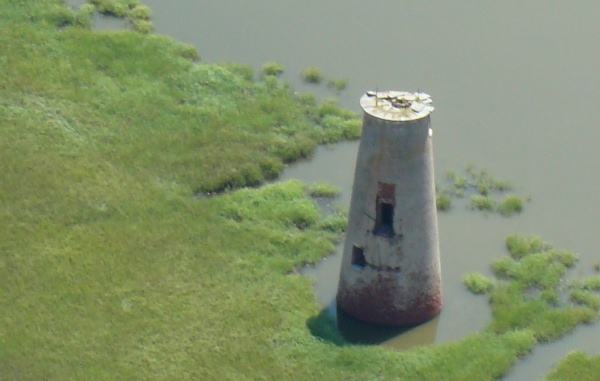 Next was Southwest Pass (1871). The decision was made to construct a metal skeleton tower to replace the brick tower that served mariners at this site. The structure would be lighter in weight and disperse that weight over a wider foundation. It was hoped this would allow the tower to overcome the problems that plagued the previous towers. The tower’s central cylindrical spine was surrounded by a 2-story dwelling at the base and 8 supporting columns tied together with a web of iron rods. The tower is ˝-mile from the brick tower it replaced and is secured to a foundation built on 185 piles driven to a depth of 33'. Its light was first activated in July of 1873. A fire erupted in the dwelling portion of the tower in May of 1894. The heat caused the iron spiral staircase to melt. The lantern room and entire central column had to be replaced. A light and fog signal were established at the end of the east jetty–constructed at the entrance to the pass. The jetty light was upgraded to serve as the primary entrance light in 1953. It performed this function until 1965 when South Pass Entrance Light replaced it. 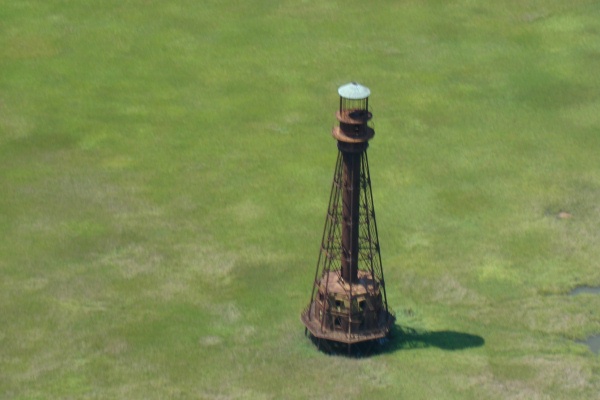 Southwest Pass Entrance Light was next on the flight. The modern Texas-tower that stood at the entrance to Southwest pass was put in-place in 1965. It was an 85' 6-sided cylindrical steel tower centered on a 2-story hexagonal reinforced concrete keeper’s quarters mounted on pilings. Its light source was a DCB-224 aerobeacon. The tower and lantern were painted red with white trim, keeper’s house painted white. The station had an array of weather instruments as a NOAA C-MAN station. It was placed in the waters just off the jetties constructed at the entrance to the pass. It had a boat dock and a helicopter landing pad and rested on a lattice of concrete pilings anchored in the floor of the gulf. Demolished by the Coast Guard in the fall of 2007 and replaced by a slender triangular skeletal tower mounted on a platform supported by 3 steep piles; the platform and pile are painted orange. 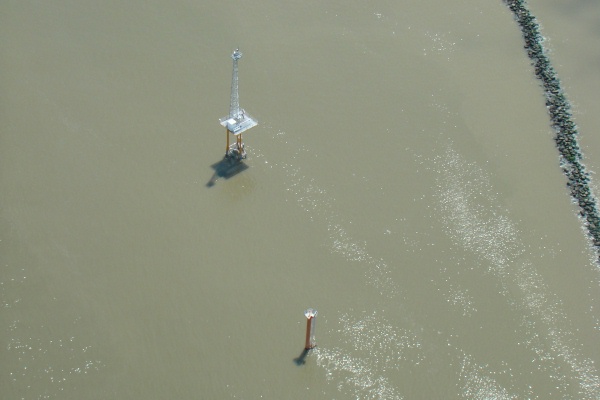 Last flyover for the flight was to photograph the remains of West Rigolets Light. Located at the eastern end of Lake Pontchartrain where it meets The Rigolets, this 1855 lighthouse was a square dwelling with a hipped roof, surmounted by a circular lantern room. Active until July of 1861, it was darkened due to the Civil War. Reactivated in November of 1862, its light came from a ship’s lantern. A 5th-Order Fresnel was returned to the lantern room in 1863 when the station was completely overhauled. In 1917 the lighthouse was raised 6' and placed on a new foundation of concrete pilings to escape the encroachment of the muddy water of the Rigolets. Abandoned in 1945 when an automated electric light was established nearby, the structure was sold to a private owner for $2,500. The lighthouse, a brick oil house, and two large circular brick supports that once held the station’s wooden cisterns were lost to Hurricane Katrina on August 29, 2005. Of the 700 homes located on the island where the West Rigolets Lighthouse stood, only 12 survived Katrina. 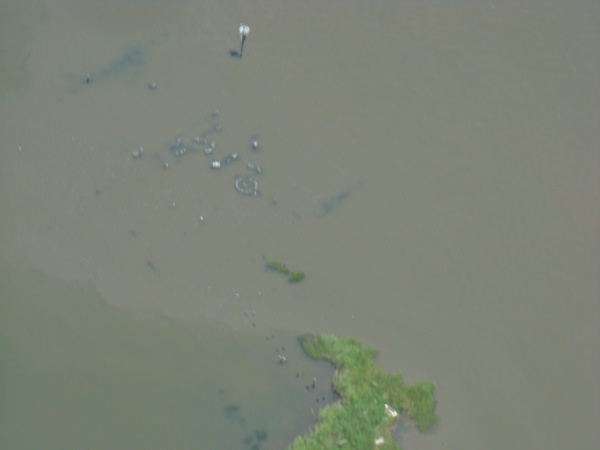 We then traveled by car to Biloxi to photograph Beau Rivage Harbor Light, a faux light that, had we been looking, we could have seen with the group when we all stopped to photograph Biloxi! It and the Broadwater Beach Hotel Marina Channel Light are a stone’s throw in opposite directions from Biloxi Light. Beau Rivage Harbor Light, MS: 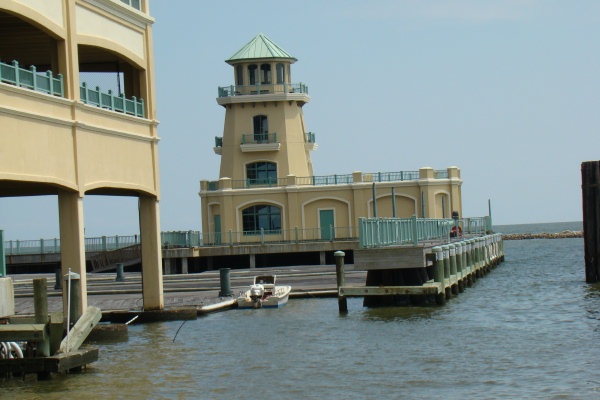
|
|
|
|
Entire Thread
|

 24 lighthouses, 4 lantern rooms, 6,271 miles, $1,011 for gas, 16 day
24 lighthouses, 4 lantern rooms, 6,271 miles, $1,011 for gas, 16 day
|
sandy
|
07/06/08 05:49 AM
|

 Re: 24 lighthouses, 4 lantern rooms, 6,271 miles, $1,011 for gas, 16 day
Re: 24 lighthouses, 4 lantern rooms, 6,271 miles, $1,011 for gas, 16 day
|
sandy
|
07/06/08 05:50 AM
|

 Re: 24 lighthouses, 4 lantern rooms, 6,271 miles, $1,011 for gas, 16 day
Re: 24 lighthouses, 4 lantern rooms, 6,271 miles, $1,011 for gas, 16 day
|
sandy
|
07/06/08 05:50 AM
|

 Re: 24 lighthouses, 4 lantern rooms, 6,271 miles, $1,011 for gas, 16 day
Re: 24 lighthouses, 4 lantern rooms, 6,271 miles, $1,011 for gas, 16 day
|
sandy
|
07/06/08 05:50 AM
|

 Re: 24 lighthouses, 4 lantern rooms, 6,271 miles, $1,011 for gas, 16 day
Re: 24 lighthouses, 4 lantern rooms, 6,271 miles, $1,011 for gas, 16 day
|
sandy
|
07/06/08 05:51 AM
|

 Re: 24 lighthouses, 4 lantern rooms, 6,271 miles, $1,011 for gas, 16 day
Re: 24 lighthouses, 4 lantern rooms, 6,271 miles, $1,011 for gas, 16 day
|
sandy
|
07/06/08 05:51 AM
|

 Re: 24 lighthouses, 4 lantern rooms, 6,271 miles, $1,011 for gas, 16 day
Re: 24 lighthouses, 4 lantern rooms, 6,271 miles, $1,011 for gas, 16 day
|
sandy
|
07/06/08 05:52 AM
|

 Re: 24 lighthouses, 4 lantern rooms, 6,271 miles, $1,011 for gas, 16 day
Re: 24 lighthouses, 4 lantern rooms, 6,271 miles, $1,011 for gas, 16 day
|
MtnHkr
|
07/06/08 02:29 PM
|

 Re: 24 lighthouses, 4 lantern rooms, 6,271 miles, $1,011 for gas, 16 day
Re: 24 lighthouses, 4 lantern rooms, 6,271 miles, $1,011 for gas, 16 day
|
Lighthouse Loon
|
07/06/08 05:08 PM
|

 Re: 24 lighthouses, 4 lantern rooms, 6,271 miles, $1,011 for gas, 16 day
Re: 24 lighthouses, 4 lantern rooms, 6,271 miles, $1,011 for gas, 16 day
|
Bill and Judy
|
07/06/08 10:06 PM
|

 Re: 24 lighthouses, 4 lantern rooms, 6,271 miles, $1,011 for gas, 16 day
Re: 24 lighthouses, 4 lantern rooms, 6,271 miles, $1,011 for gas, 16 day
|
Dave H
|
07/07/08 04:49 PM
|

 Re: 24 lighthouses, 4 lantern rooms, 6,271 miles, $1,011 for gas, 16 day
Re: 24 lighthouses, 4 lantern rooms, 6,271 miles, $1,011 for gas, 16 day
|
kikigl
|
07/08/08 08:38 PM
|

 Re: 24 lighthouses, 4 lantern rooms, 6,271 miles, $1,011 for gas, 16 day
Re: 24 lighthouses, 4 lantern rooms, 6,271 miles, $1,011 for gas, 16 day
|
Bob Taylor
|
07/09/08 02:00 PM
|

 Re: 24 lighthouses, 4 lantern rooms, 6,271 miles, $1,011 for gas, 16 day
Re: 24 lighthouses, 4 lantern rooms, 6,271 miles, $1,011 for gas, 16 day
|
sandy
|
07/09/08 02:20 PM
|

 Re: 24 lighthouses, 4 lantern rooms, 6,271 miles, $1,011 for gas, 16 day
Re: 24 lighthouses, 4 lantern rooms, 6,271 miles, $1,011 for gas, 16 day
|
wheland
|
07/09/08 03:34 PM
|

 Re: 24 lighthouses, 4 lantern rooms, 6,271 miles, $1,011 for gas, 16 day
Re: 24 lighthouses, 4 lantern rooms, 6,271 miles, $1,011 for gas, 16 day
|
Tybee_Sullivan
|
07/10/08 09:42 PM
|
|
|
|
Forums39
Topics16,980
Posts184,642
Members2,583
| |
Most Online10,155
Jan 14th, 2020
|
|
|
1 registered members (Rock),
1,814
guests, and 0
spiders. |
|
Key:
Admin,
Global Mod,
Mod
|
|
|

